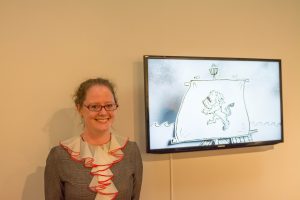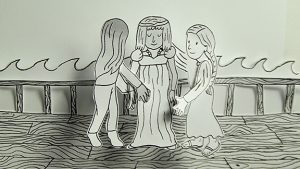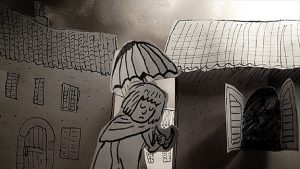
New York-based artist Annie Poon sees the story of her own life unfold as she watches her soon to be released short film “The Split House.”
The five-`minute, stop-motion animation represents the past decade of her life. It embodies more than 10 years of work on the film, more than 10 years of dealing with the mental health challenges it portrays and a lifetime of relying on her testimony of the gospel of Jesus Christ to find hope and meaning in life.
Poon says being so transparent about her struggles, which include dealing with bipolar disorder, has made her feel more vulnerable than ever before. However, she feels comfortable sharing these experiences through creative expression and animation.
“The Split House” and a collection of artwork was unveiled Friday, June 3, at the Writ and Vision Gallery in Provo.
Poon’s vast portfolio of animations, artwork, comics and sculpture have received acclaim from film festivals and galleries around the world. Her 2004 animation “Runaway Bathtub” resides in the New York Museum of Modern Art’s permanent collection.
She’s also produced commissioned works for BYU and The Church of Jesus Christ of Latter-day Saints, including a well known animation commissioned by the church entitled “The Shiny Bicycle.”
Much of Poon’s work is influenced by her faith and connection to The Church of Jesus Christ of Latter-day Saints. “The Book of Visions” is about heavenly messengers appearing to children, including Joan of Arc, Black Elk and Joseph Smith.
Other animated films include stories about David and Goliath and the Book of Mormon character Shiz. She’s currently working on a book filled with more than 50 sketches of her favorite Book of Mormon chapters.
“I would be happy if all I ever did was draw pictures for the primary kids. At one point I said, ‘That’s all I’m going to do. I’m going to consecrate all my time to the church,'” Poon said. “I try to be more realistic now, but nothing makes me happier than trying to infuse my art with the Spirit.”
Poon’s journey as an artist began at a young age. She grew up in Connecticut in a large family, where her mother, Barbara Benac, constantly encouraged Annie to explore her creative side.
“My mom would take me into New York City when I was 4 and 5 years old, and she would take me to the Met,” Poon said. “She would give me a nickel for every artist that I could identify.”
Annie spent a term studying at BYU, but soon realized she had a desire to study the art of New York City, so she transferred to the School of Visual Arts in Manhattan. She graduated in painting and drawing and met her husband Kah Leong Poon during her last year of study.
Not long after they first met, he asked her why she kept creating such serious conceptual artwork and paintings that didn’t reflect her fun personality. That’s when her interest in stop motion took root.
It started with a flip book she made of kissing her husband.
“My sketchbook is the stage,” Poon said.

Her unique style of stop-motion animation uses cartoon-like ink drawings that have been cut out and arranged on top of various hand-drawn scenery and backdrops.
Poon said paper was her favorite toy as a child. She said paper is clean, cheap and she can make just about anything from it. Animation is her medium of choice because of her ability to use humor and tell stories with it.
She also appreciates that she can do everything on her own. Poon said she enjoys collaborating with other artists and musicians but likes the freedom of not needing to rely on other people to achieve her vision. She handles all parts of the process, from sketching and animating to editing, and she even produces original soundtracks for each film.
Poon and her husband currently live in New York and work as full-time creatives: he’s a photographer, and she’s an animator.
Annie’s close friend and collaborator Glen Nelson, curator of her upcoming gallery, said he most admires the personal meaning behind her artwork.
“I find that she’s made herself very vulnerable,” Nelson said. “A lot of artists are kind of ‘behind the mask,’ you know? Her vulnerability really draws the viewer in. It’s heart-on-your-sleeve kind of work. It’s rare.”

The title of “The Split House” refers to several ideas and personal experiences. The film opens in the city of Split, Croatia, where Poon served her LDS mission. A woman, representing Poon, approaches the home of a healer, who was inspired by a convert from her mission.
Split also refers to the split mind — the bipolar brain at war with itself. Bipolar disorder, depression and other health challenges have taken their toll on Poon throughout her life.
Healing and disorder, jubilation and desperation, good and evil; dualities and splits are repeated throughout Poon’s work, often portrayed through visual contrast.
“Black and white is a subject in itself,” Poon said.

This is especially apparent in another piece from the gallery, “Thou Art Not Yet As Job,” a pen and ink depiction of the prophet Joseph Smith suffering in Liberty Jail.
“Here in Liberty Jail, the contrast of black and white sets in to stark relief the other great duality: good and evil,” Writ and Vision owner Brad Kramer said in “The Split House” gallery catalog. “‘Thou Art Not Yet As Job’ is part of the answer the Lord gives to the slowly dying Prophet’s indignant petition, his invocation of what is known commonly as the ‘problem of evil’ — how can a being so loving and powerful permit the suffering of so many?”
Her sister Mary Madabhushi said she appreciates how Poon balances heavy concepts with a healthy dose of humor and fantasy.
“I really liked the early versions (of “The Split House”), and then she added the second half in prep for this show. It was really heavy, and dealt with some very personal stuff, but it came together so nicely, I don’t know how she is able to strike that balance but it all works,” Madabhushi said.
Not all of the symbolism in the film will be understandable to the viewer, which is the way Annie means for it to be. She’s interested in being open and vulnerable, but leaving most of the film up to interpretation. She hopes viewers can connect with “The Split House” and understand both the struggles and faith she experiences in life daily.
“I do think this film represents me best. One thing I liked about ‘The Split House’ is the feeling of hope at the end,” Annie said. “I’m very happy with that.”




